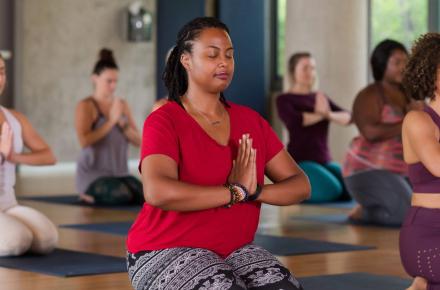Balance Your Body, Not Your Yoga Practice


A widely held belief says that if you practice the postures diligently, yoga will bring agility, vitality, and balance. In my evaluations of thousands of yoga practitioners, I have found few who are in balance from a musculoskeletal point of view.
Balance can only be achieved if you are aware of your imbalances and restrictions and know which postures will be best suited for that condition. This knowledge will bring a more focused, aware practice. This practice will start to bring the body into balance and reduce or eliminate your pain. Like any discipline dealing with the musculoskeletal system, the muscles must be trained to be in balance. Failure to do so will result in pain.
I have been a yoga instructor for 20 years and a neuromuscular therapist for 25 years. Combining the knowledge contained in these two disciplines enables me to accurately choose which poses my body requires to become balanced and pain free. My approach emphasizes identifying muscle imbalances, choosing poses that will bring the musculoskeletal system into balance, and enhancing that experience with pranayama and meditation.
Modern yoga that is based in gymnastics can correct muscle imbalances in a relatively short time, but only if you learn to identify these imbalances and then practice the specific postures for those imbalances. Yoga has developed into a practice of performing poses. To achieve even greater benefit from your practice, the emphasis should be on selecting the correct pose that will bring the musculoskeletal system back into balance.
Performing yoga poses with an emphasis on correcting muscle imbalances instead of practicing poses will bring superior physical benefits. What is lacking in many yoga practices is the ability to evaluate and know which postures would be beneficial at this time for a particular body and the conditions it is presenting. There are hundreds of poses to choose from when practicing yoga. Learning and understanding the poses, and what muscles they are stretching or strengthening, will bring you the most benefit. Choosing the correct pose for your current muscle imbalances will result in the most therapeutic outcome.
Research has shown that when the muscles are in balance, many painful conditions are eliminated and range of motion increases. The body moves with more ease and grace. When the muscular system is in balance, the energetic life force (prana) flows better as well. This is one of the greatest benefits of asana practice.
Ask yourself the following questions every time you are practicing your yoga postures:
- Which muscles will I stretch today? Why?
- Which muscles will I strengthen today? Why?
- Which muscles will I neglect today? Why?
- Why did I choose a particular pose?
- What are my current muscle imbalances?
- Are the poses I selected the correct ones for my current imbalances?
- Who developed these poses and for what reason?
- Do you know?
- Does your teacher know?
If you cannot answer these questions, you are not receiving the maximum benefit from your yoga practice. You might be training your body to be out of balance.
As a neuromuscular therapist, I have treated many people for yoga injuries. The injuries are not because yoga is dangerous. Yoga is simply a tool. A tool does not make a mistake. It is the user of the tool who can make an error due to lack of knowledge that can cause harm. It is essential to know and recognize which postures to perform for a particular body condition and body type.
Find out about upcoming programs with Lee Albert at Kripalu.
Excerpted with permission from Yoga for Pain Relief: A New Approach to an Ancient Practice, © 2017 by Lee Albert, NMT.


















































